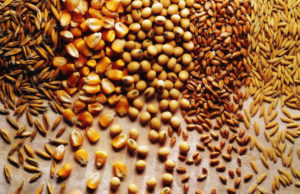 Grain futures were mixed on Wednesday with corn and wheat advancing, while soybeans posted a minor daily decline. Based on crop-insurance data, the actual drop in areas planted to soybeans was smaller than previously estimated, while insurance claims on corn covered more acres in September than in August. Claims on wheat areas also rose from August, according to the USDA.
Grain futures were mixed on Wednesday with corn and wheat advancing, while soybeans posted a minor daily decline. Based on crop-insurance data, the actual drop in areas planted to soybeans was smaller than previously estimated, while insurance claims on corn covered more acres in September than in August. Claims on wheat areas also rose from August, according to the USDA.
On the Chicago Board of Trade, soybeans futures for delivery in November fell by 0.12% to $13.4138 per bushel at 8:55 GMT. Prices held in range between days high of $13.4588 and $13.3638 a bushel, the lowest since August 23. The oilseed slipped 0.5% on Tuesday and marked a third consecutive daily decline, the longest losing streak since July 25. The contract has declined 2.9% so far this week.
Soybeans extended their weekly decline as the USDAs Farm Service Agency reported that growers filed crop-insurance claims covering 1.69 million acres as of September 1, which implied that farmers sowed 226 000 acres to soybeans less than USDAs latest estimate at 76.378 million acres.
Anne Frick a senior oilseed analyst at Jefferies Bache, said for Bloomberg: “The claims are below the 500,000 acres to 1 million acres some people expected to be cut. The numbers suggest we are not looking at a big reduction in USDA planted acreage.”
DTN reported yesterday that showers and warm temperatures will favor late-filling Midwest summer crops in the next few days. High rainfall over the eastern and parts of the western Midwest and lack of significant cold weather threats will allow still immature crops to move towards maturity, easing stress on soybeans. At the same time, warm temperatures and a few showers will favor late-maturing corn and soybeans in the Northern Plains.
The U.S. Department of Agriculture trimmed its crop estimate to 3.149 billion bushels this year on September 12, down from August’s 3.255 billion, as a result of recent unfavorable weather conditions. Analysts surveyed by Bloomberg expected a drop to 3.134 billion bushels. Yields projections were trimmed in nine Midwest states where drought vastly expanded.
Corn advances
Meanwhile, corn futures for delivery in December rose by 0.29% to $4.5563 per bushel at 9:12 GMT. Prices held in range between days high of $4.5650 and a 37-month low of $4.5338 per bushel. The grain fell 0.7% on Tuesday, extending its weekly decline to over 0.7% after losing more than 5% in the preceding two five-day periods.
Corn rebounded off a freshly hit three-year low as crop-insurance claims surged after rains prevented farmers from planting. The USDA’s Farm Service Agency reported yesterday that insurance claims covered 3.57 million of acres sowed to corn as of September 1, up from Augusts 3.41 million and last years total of 262 467 acres.
Luke Mathews, a commodity strategist at Commonwealth Bank of Australia wrote in a note today: “This revision may support a downgrade to the U.S. corn production estimates in the October WASDE report.”
The USDA said last Thursday that the nation will harvest a record 13.843 billion bushels of corn in 2013, confounding analysts’ projections for a drop to 13.641 billion bushels from 13.763 billion estimated in August. Domestic output will be 28% higher than last year’s drought damaged crop. U.S. corn reserves will total 1.855 billion bushels on August 31, 2014, above the previous estimate of 1.837 billion. Global inventories will surge 24% to a 12-year high, the agency reported.
The USDA reported on Monday that the corn crop condition marked a slight deterioration last week. As of September 15, 53% of the plants were rated good-excellent, compared to 54% a week earlier and 24% in 2012. Meanwhile, 18% of the crop was categorized as “Very poor” and “Poor”, 1% above the previous week and well below last year’s 50%.
The government agency also said that corn harvesting fell well behind last year’s pace. As of September 15, 4% of the crop was reaped, compared to the five-year average of 10% and 24% in the comparable period in 2012. Meanwhile, the report showed that only 22% of the plants were in the mature stage, well below the five-year average 41% and last year’s 73% during the comparable week.
Wheat gains as well
Wheat gained on the day as wheat crop-insurance claims also rose in September. Wheat for delivery in December traded at $6.4488 per bushel at 9:16 GMT, up 0.26% on the day. Prices ranged between days high and low of $6.4600 and $6.4200 per bushel respectively. The grain rose by 0.2% on Tuesday and extended its weekly advance to 0.7%.
The USDA’s Farm Service Agency said yesterday that farmers crop-insurance claims covered 1.98 million acres of wheat in September, up from Augusts 1.74 million. This provided a boost to the contract but could not shift the grains bearish outlook. The Australian Bureau of Agricultural and Resource Economics and Sciences said yesterday that the grain is expected to extend its decline amid ample global supply outlook. “Wheat production is forecast to increase in most of the major growing regions in the northern hemisphere, particularly the Black Sea area and Europe. The extent of the decline may be less than other varieties of wheat, reflecting a smaller increase in world production of higher protein varieties, including U.S. hard-red winter wheat,” Abares said.
DTN said on September 17 that recent rainfall has helped improve planting moisture for the winter wheat crop through Kansas and eastern Colorado. The USDA said in its crop report on Monday that as of September 15, 12% of the crop was planted, matching the five-year average pace and surpassing last week’s 10%. This marked a 7% advance from the preceding period.
Meanwhile, the government agency said that as of last week, 90% of the spring wheat crop was reaped, compared to the five-year average of 87%. This marked a 10% advance from the preceding week but fell behind last year’s 99% of crop harvested.





